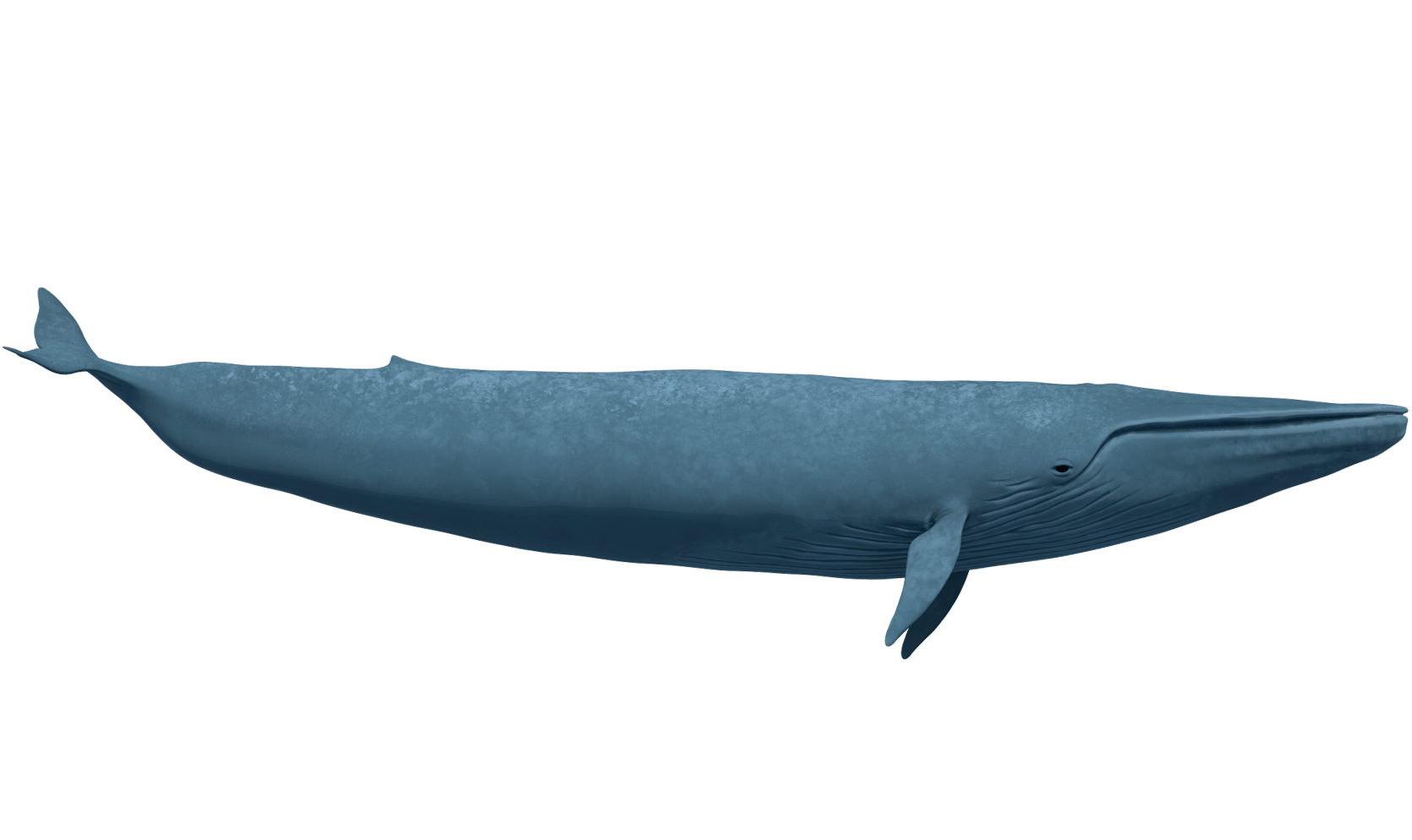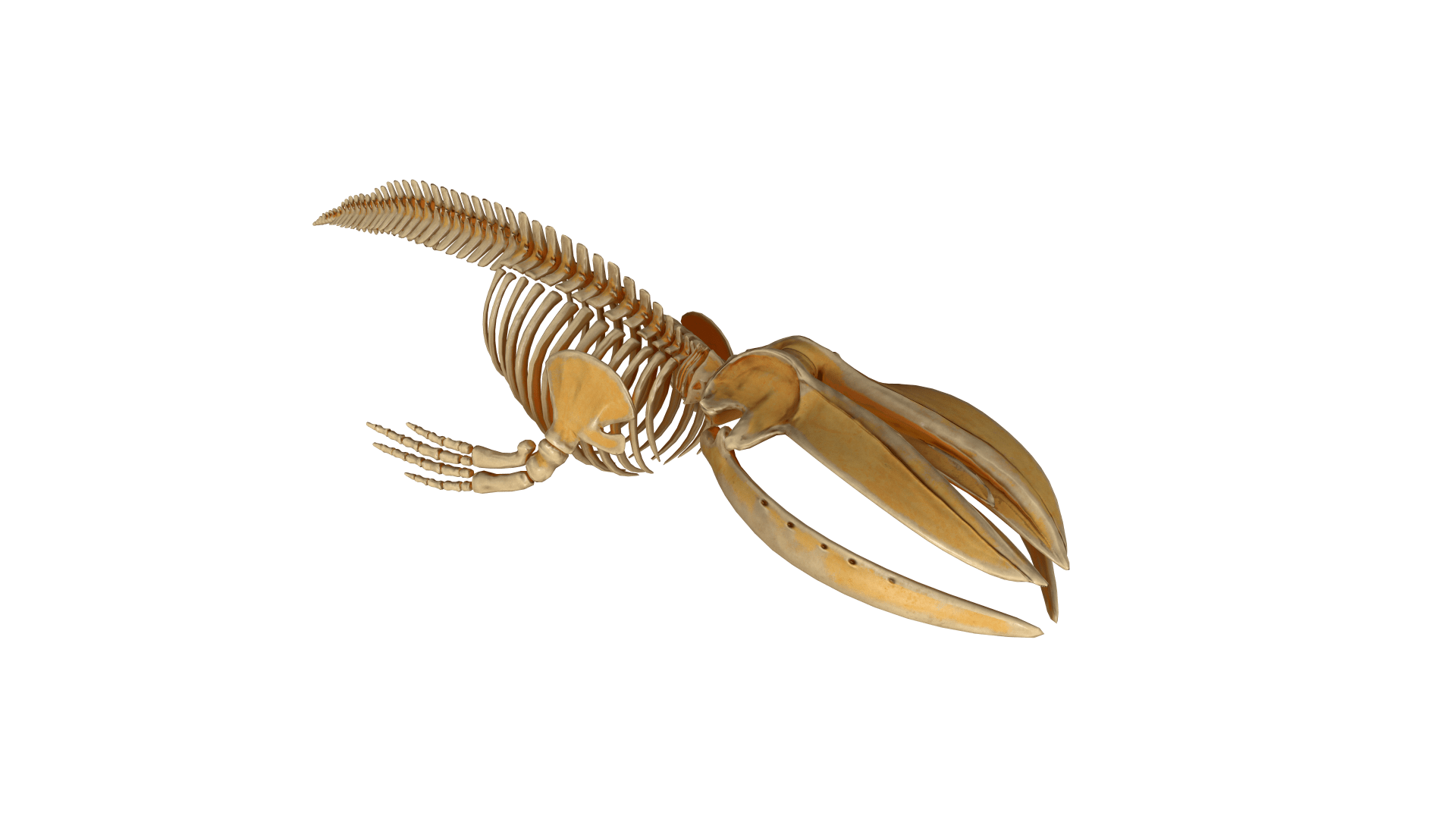The blue whale is not only the largest of all the whales, but also the largest animal on the planet!
B285 was first photographed in August 1994 by the Mingan Island Cetacean Study (MICS). She was already adult in size, which meant she must have been between 5 and 15 years old, or perhaps even older.
A small skin sample taken for a biopsy revealed that B285 was a female. B285 was sighted several times in the St. Lawrence Estuary during the 10 years preceding her death in 2004. She was recognizable by the pattern of spots on her body; in blue whales, these patterns are unique to each individual.
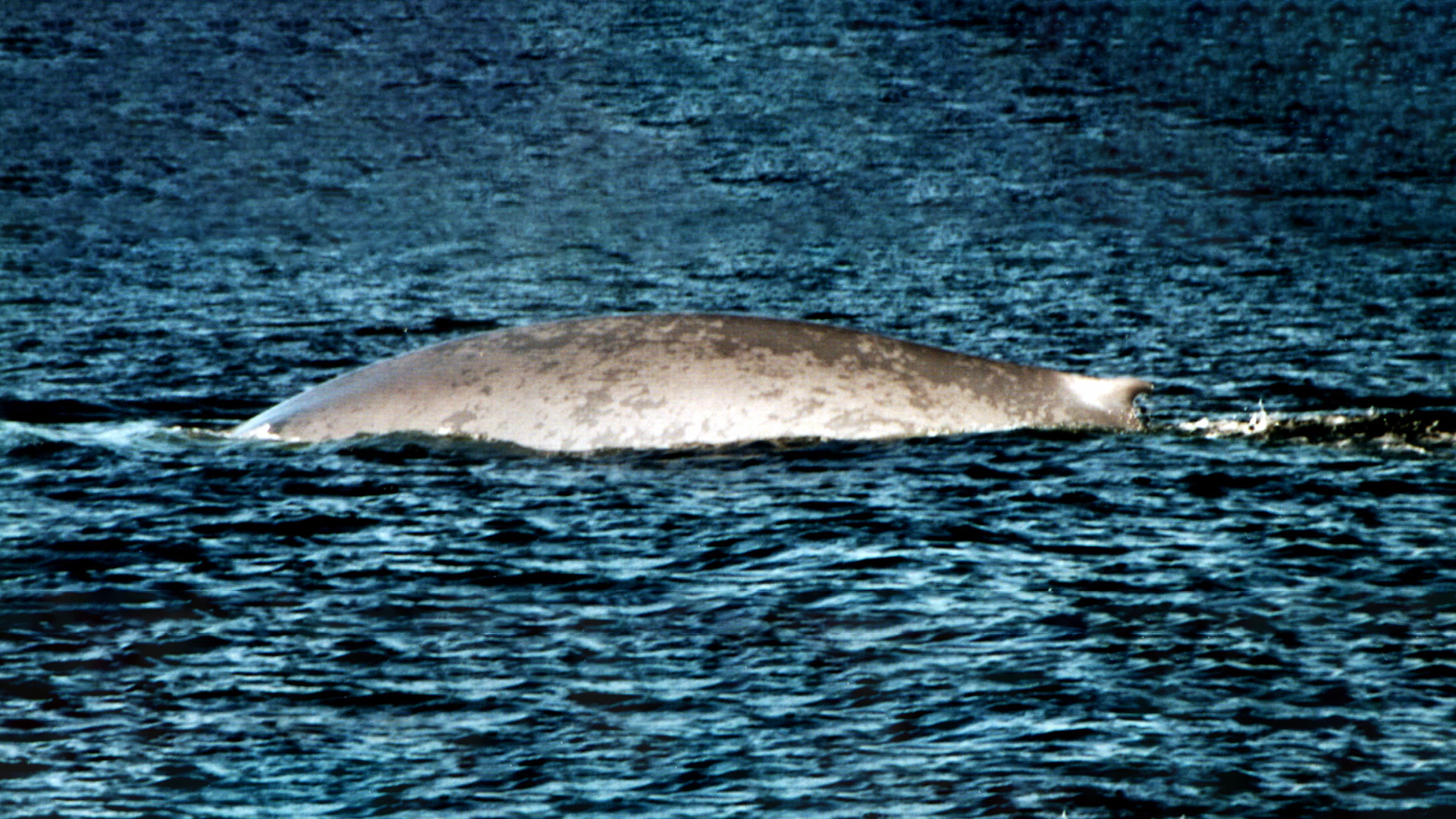
Credits: Meriscope
Photo of blue whale B285 taken in 2003

On November 22, 2004, a blue whale carcass washes ashore at the mouth of the Moisie River near Sept-Îles. The pattern of spots on its back reveals that it is B285. On the other hand, there were no obvious marks, scars or signs of illness, so it could not be determined how she died.
Since she is far too big to fit in the museum, the Tadoussac-based Group for Research and Education on Marine Mammals (GREMM) collects only her lower jaws for its skeleton exhibition. The rest of the whale is buried directly on site to prevent the odours of decomposition from becoming unbearable for local residents. Nothing like the stench of tonnes of rotting blubber!
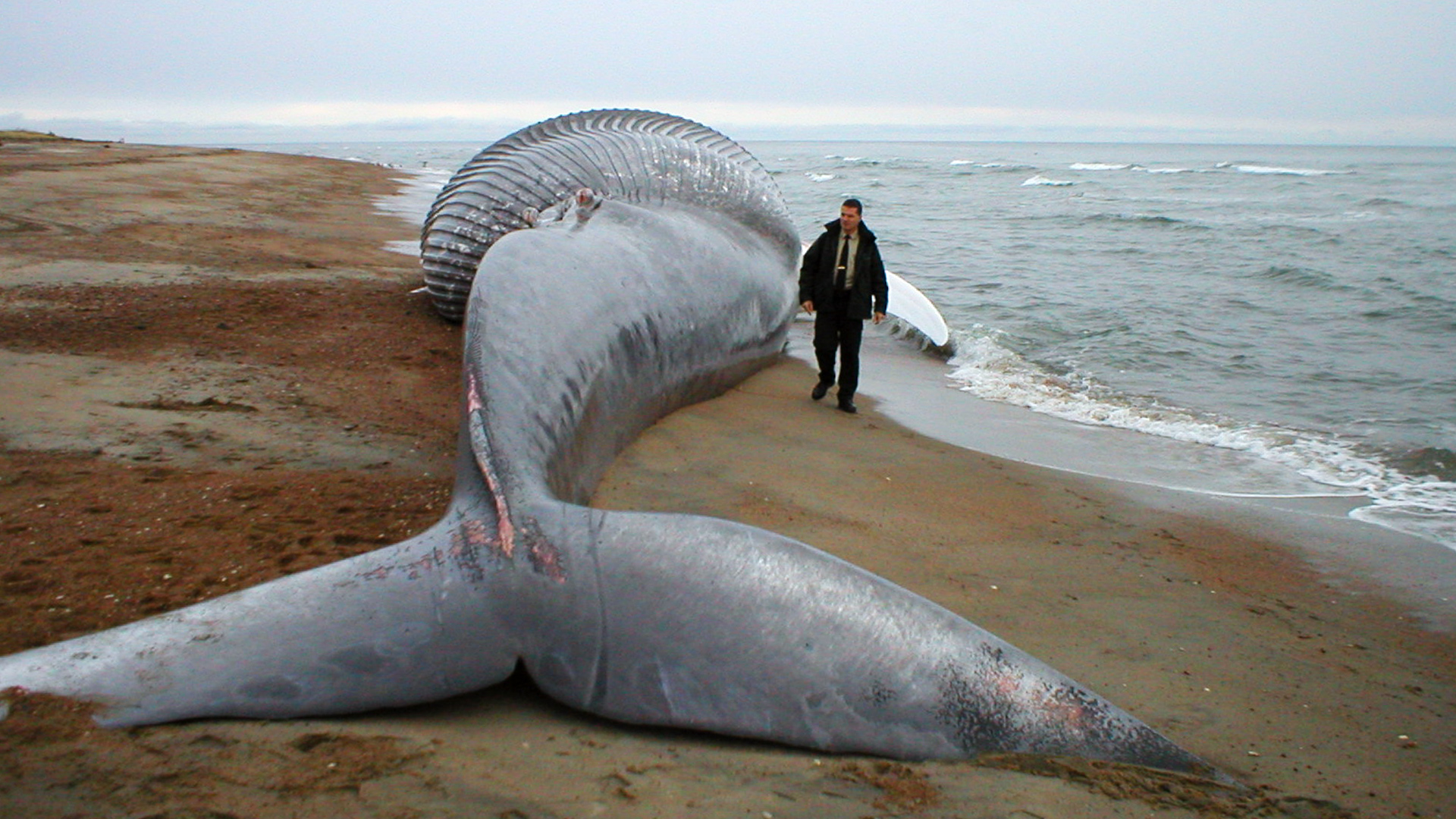
Credits: GREMM
Seeing the carcass washed up on shore, one can appreciate just how immense this animal actually is.
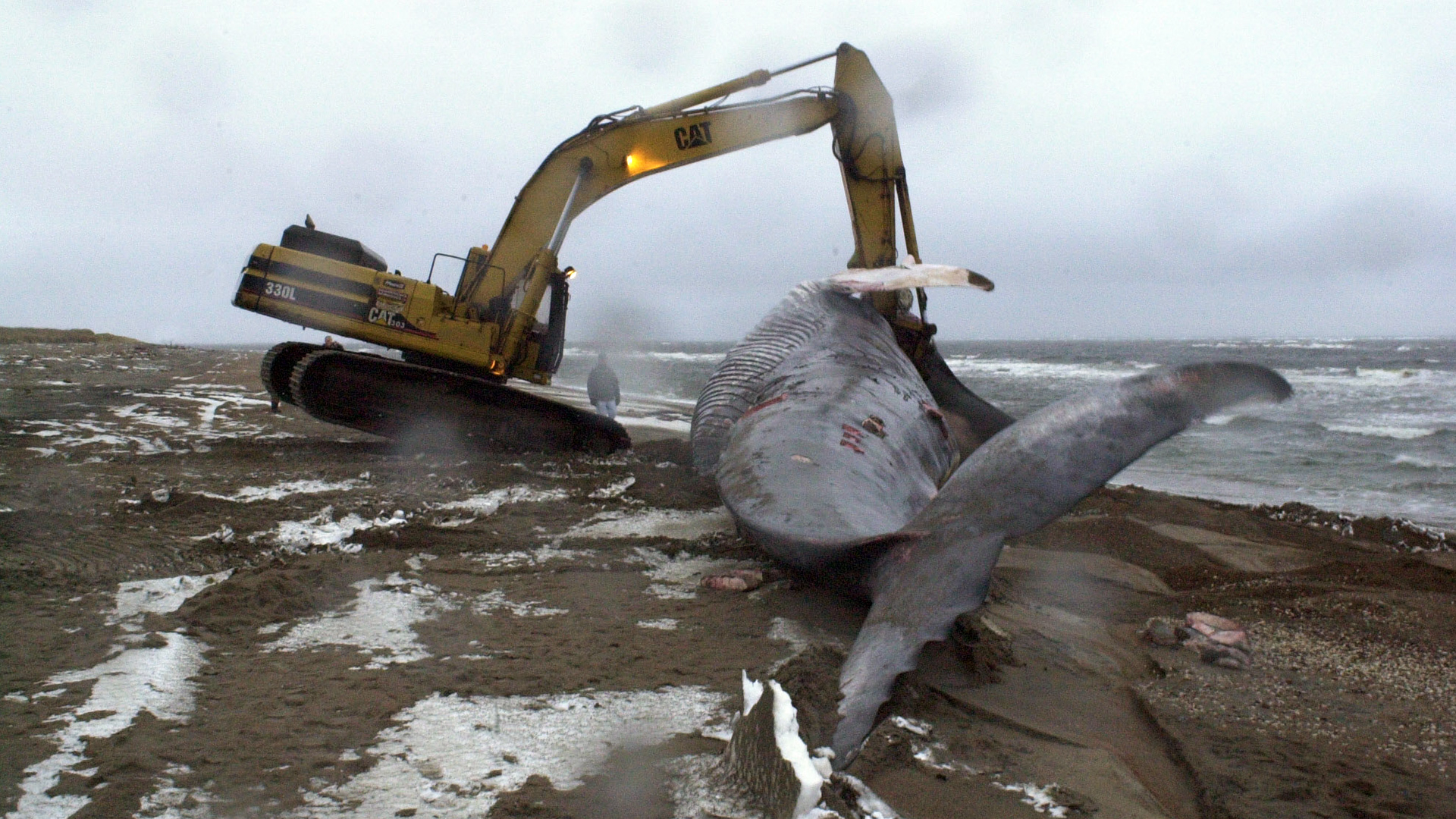
Credits: GREMM
The blue whale is so heavy that the crane can barely turn it over.
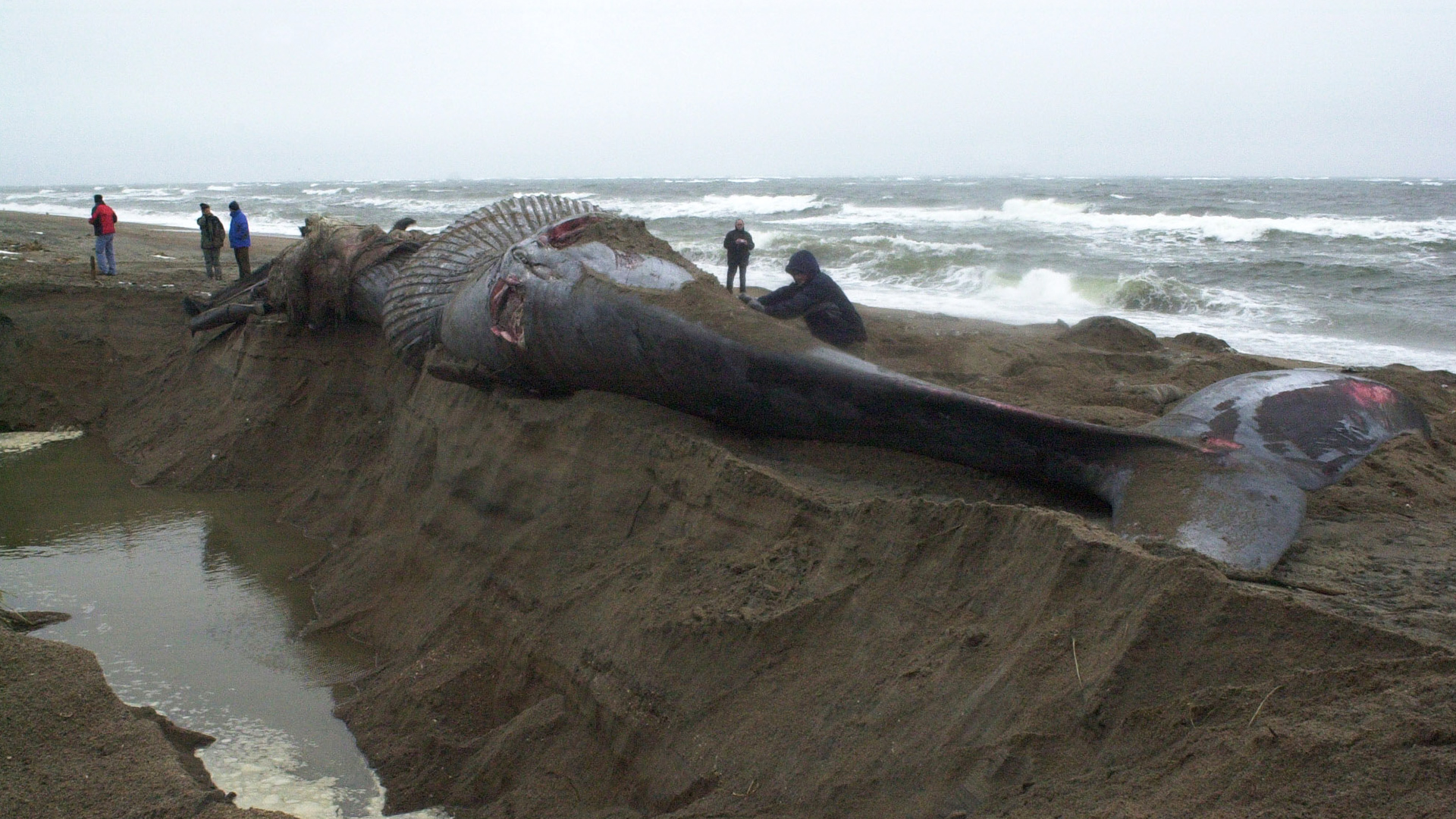
Credits: GREMM
An enormous pit was excavated in the sand to bury B285. She is most likely still there.

B285’s baleen has also been preserved. Analyzing them might provide clues to this individual’s life history in the ocean. Indeed, the atomic composition of baleen is influenced by the environmental conditions in which the whale lived: water temperature, salinity, etc.
The same goes for human hair: as it grows, it keeps a record of the environments in which we live. Who knows, perhaps B285’s baleen contains answers to the secrets of her species’ migration?
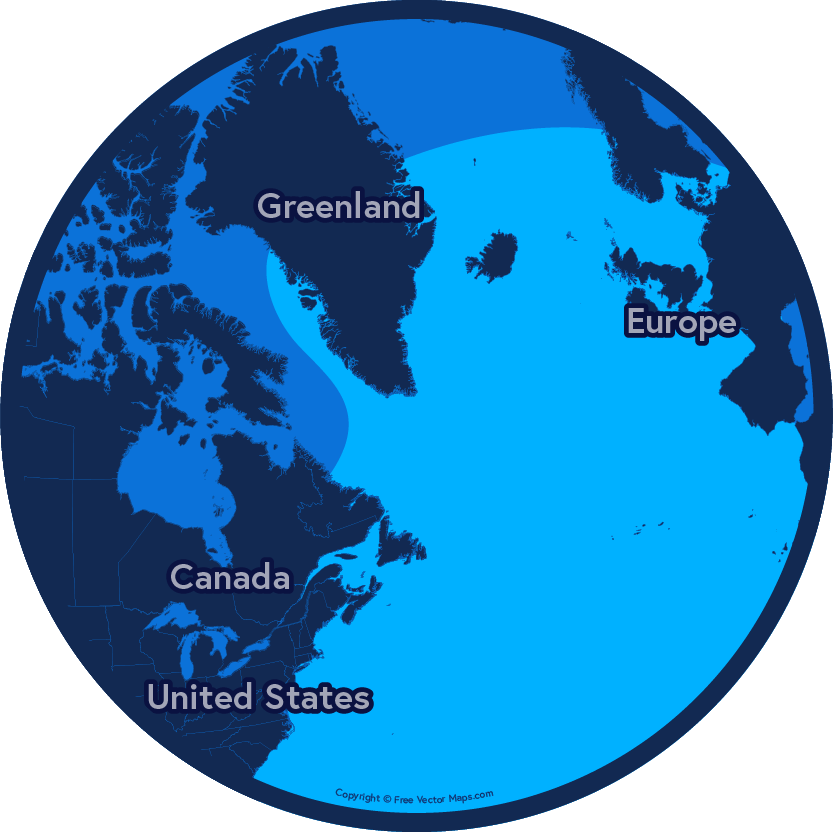
The blue whale’s range spans much of the North Atlantic, but where do blue whales like B285 go when they leave the St. Lawrence? It’s hard to say.
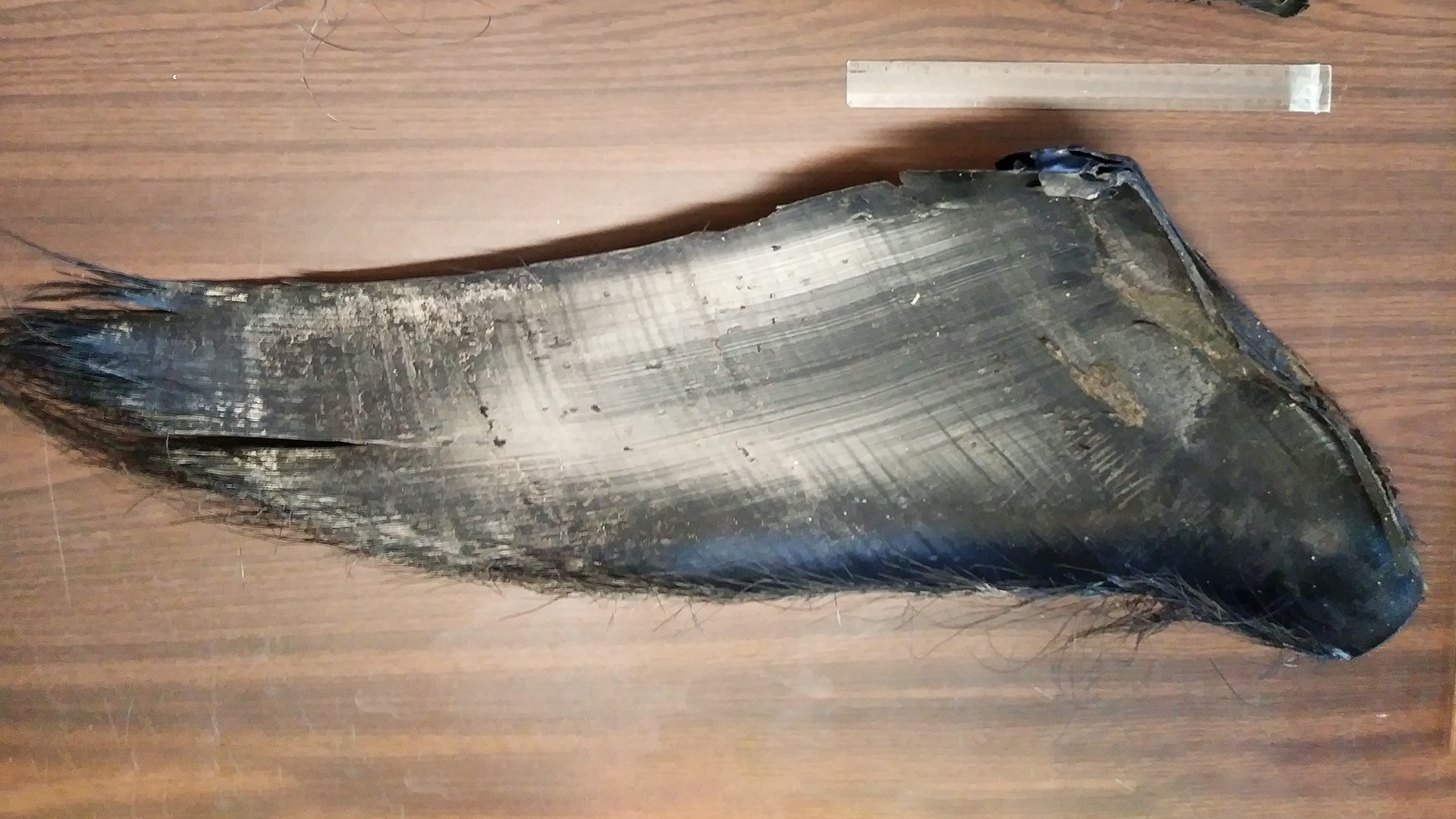
Credits: GREMM
The colour of baleen varies from one species to another. Those of the blue whale are black.

B285 has never been observed with a calf. Is it because she never experienced motherhood or because she was always somewhere else whenever she had a newborn in tow? In the past few decades, very few calves of this endangered species have been seen in the St. Lawrence.
The St. Lawrence is a known feeding ground for these krill-loving whales, but when they leave the area, what they do and where they go is a mystery.
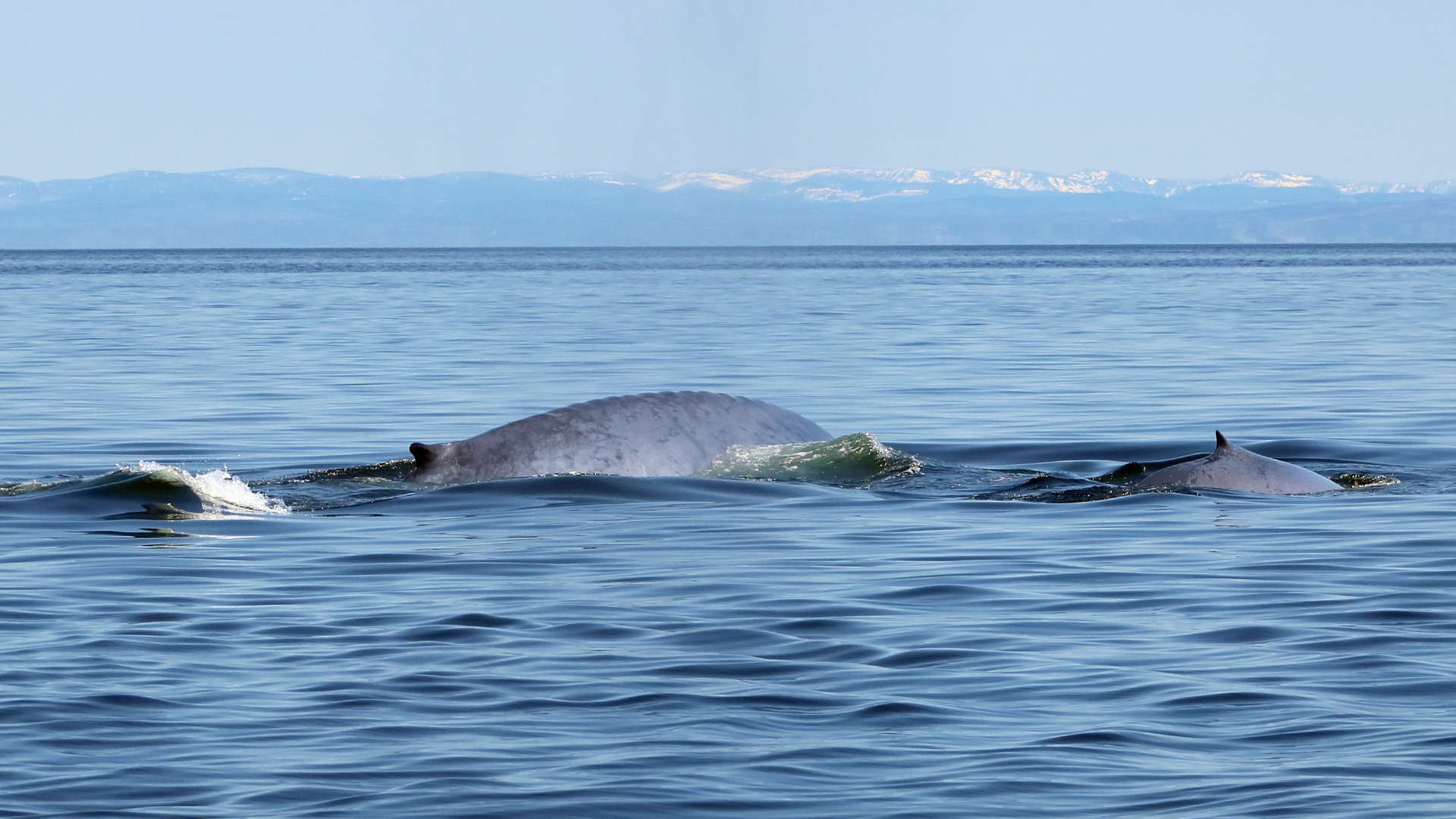
Credits: René Roy
B329 and her calf B567 swim together. They form one of the few mother-calf pairs ever observed in the St. Lawrence.

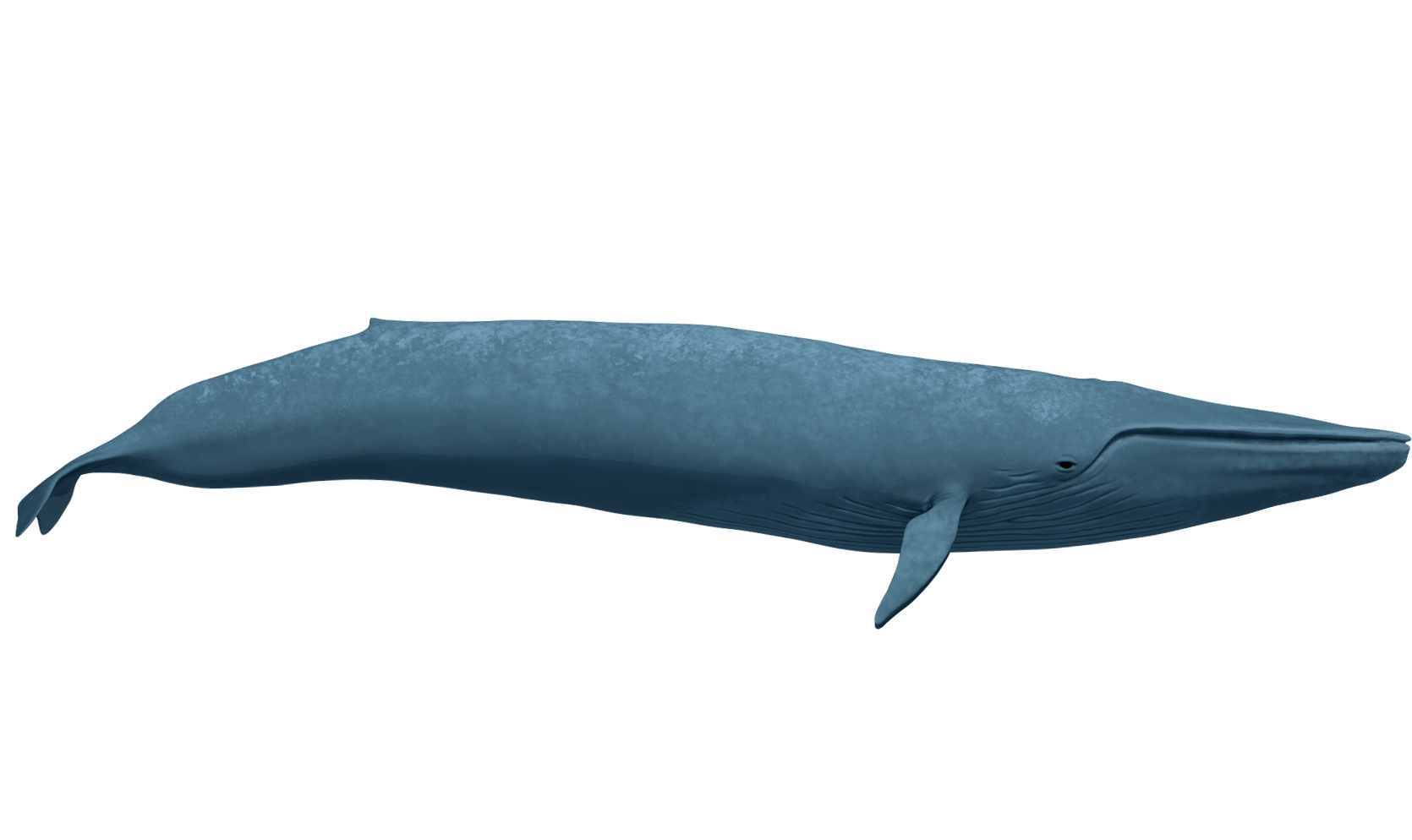
Despite their gigantic size, blue whales like B285 feed exclusively on tiny prey. More precisely, these whales specialize in krill, a small, shrimp-like crustacean.
They must ingest over one tonne every day to meet their dietary needs! Every bite the whale takes requires a dose of energy, so it must make sure that each gulp is worth the effort.
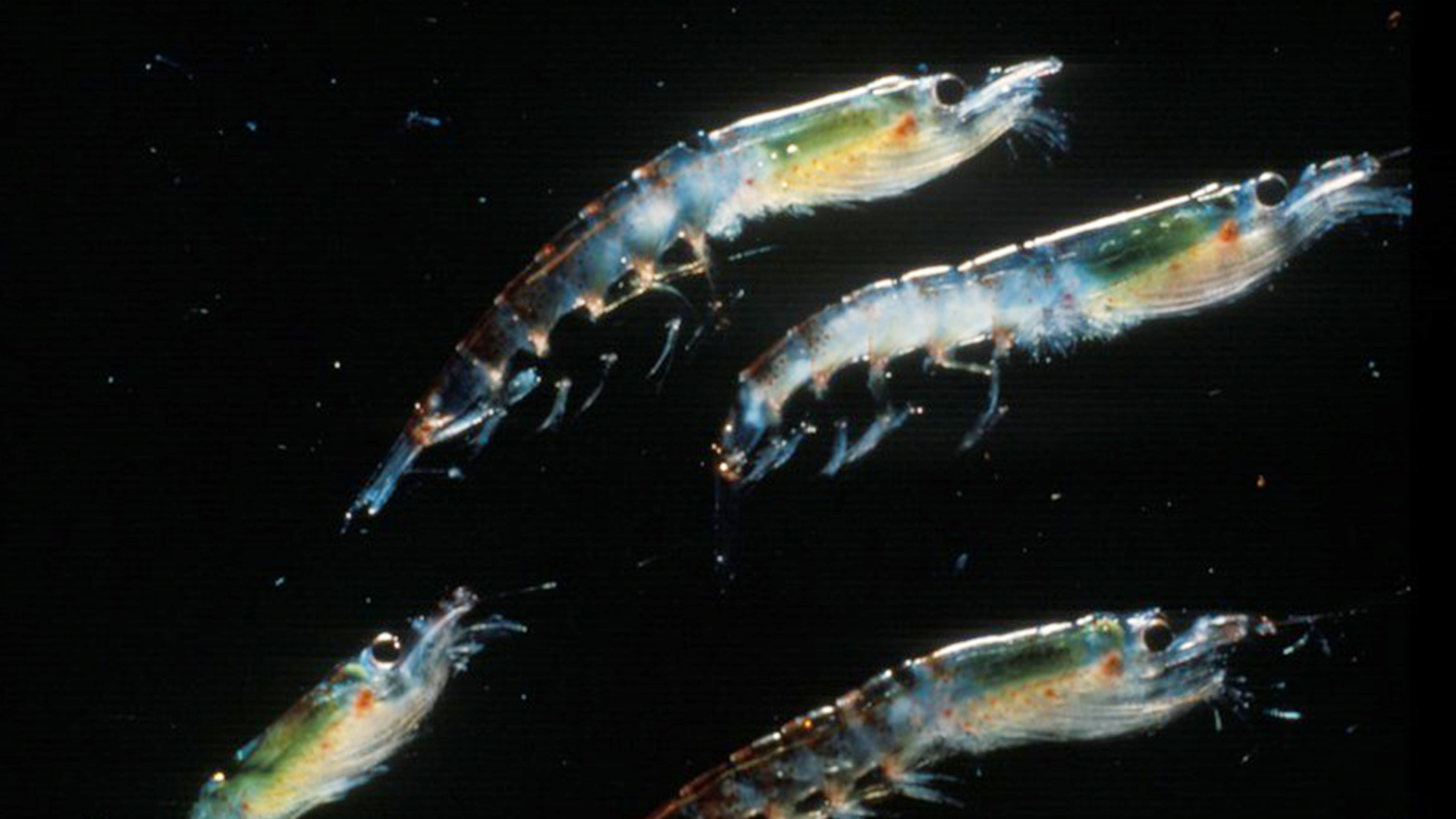
Credits: NOAA NMFS SWFSC Antarctic Marine Living Resources (AMLR) Program
Credits: Research conducted by the GEMM Lab at Oregon State University. Drone footage filmed by Todd Chandler.

Unlike most whales, which have teeth, some have what is called baleen. Each baleen is a horny plate with a hairy edge. They hang by the hundreds from the animal’s palate, each one fitting snugly against the next one, hairs facing inward.
They are made of keratin, the same protein as our hair and nails. Together, they form a huge sieve. Different species can be distinguished by their baleen.
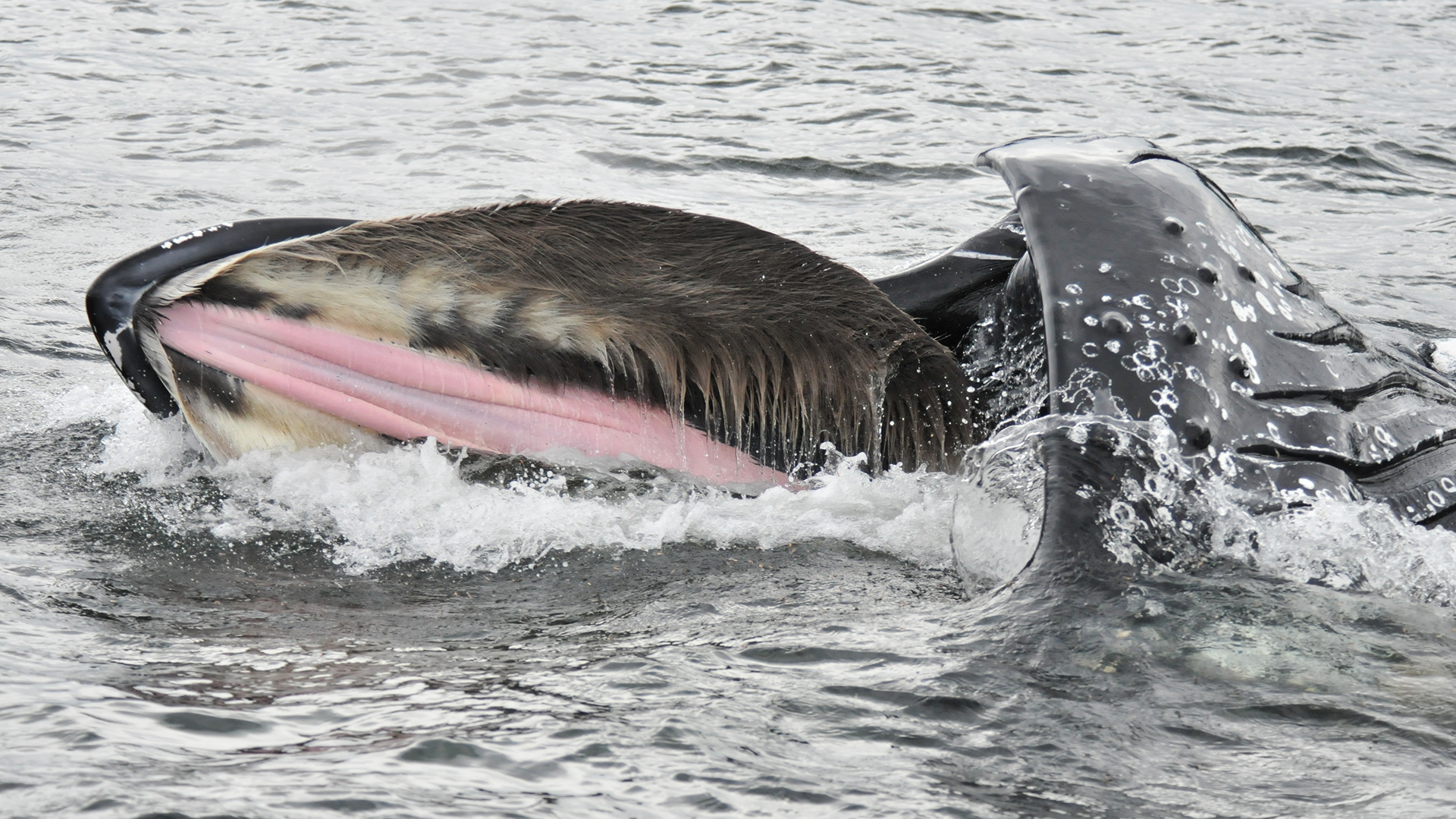
Credits: GREMM
The baleen-covered palate of this humpback whale is clearly visible as the animal lunges out of the water with its mouth wide open.
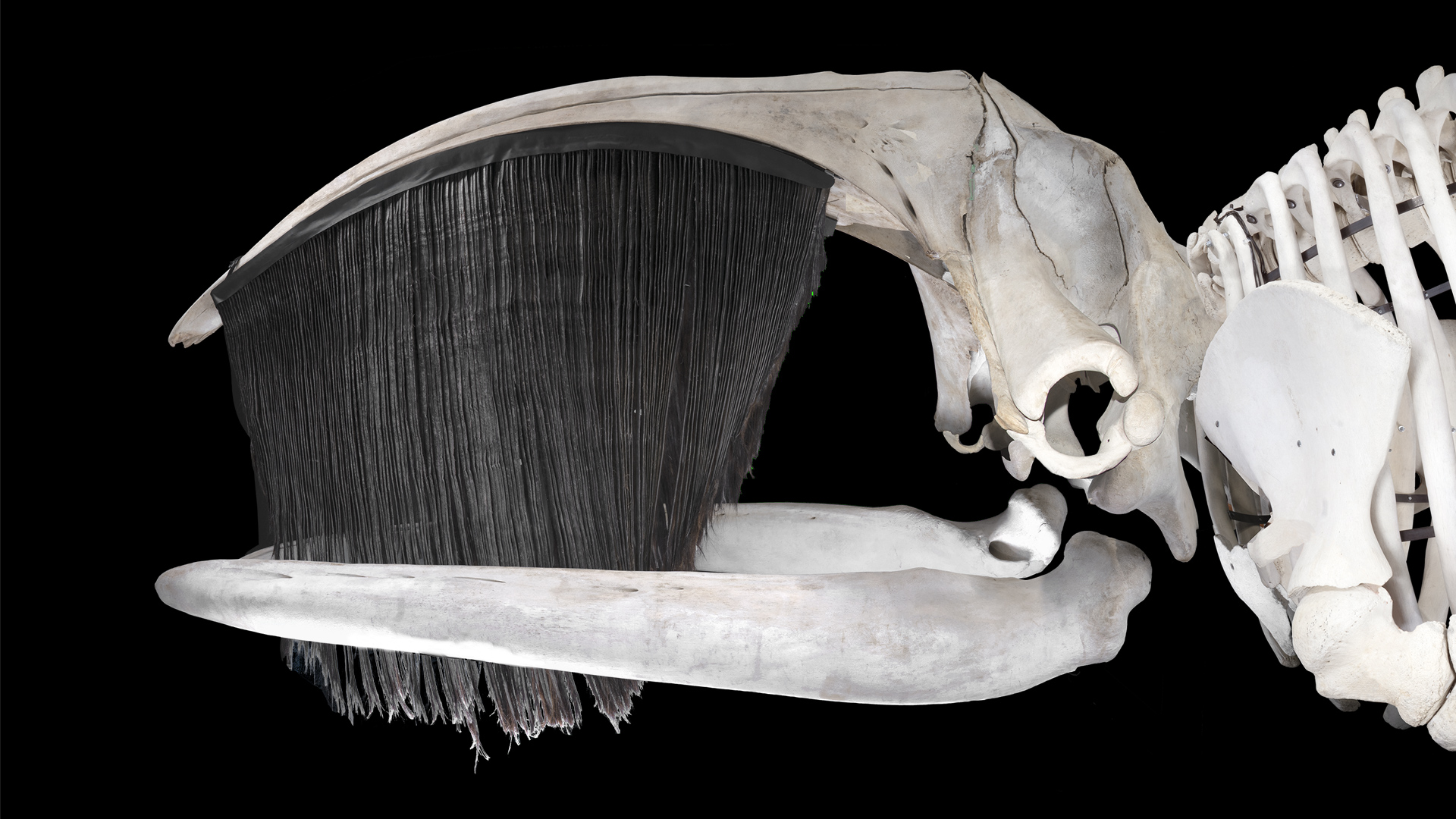
Credits: GREMM
The baleen of the right whale measure over 2 m long.
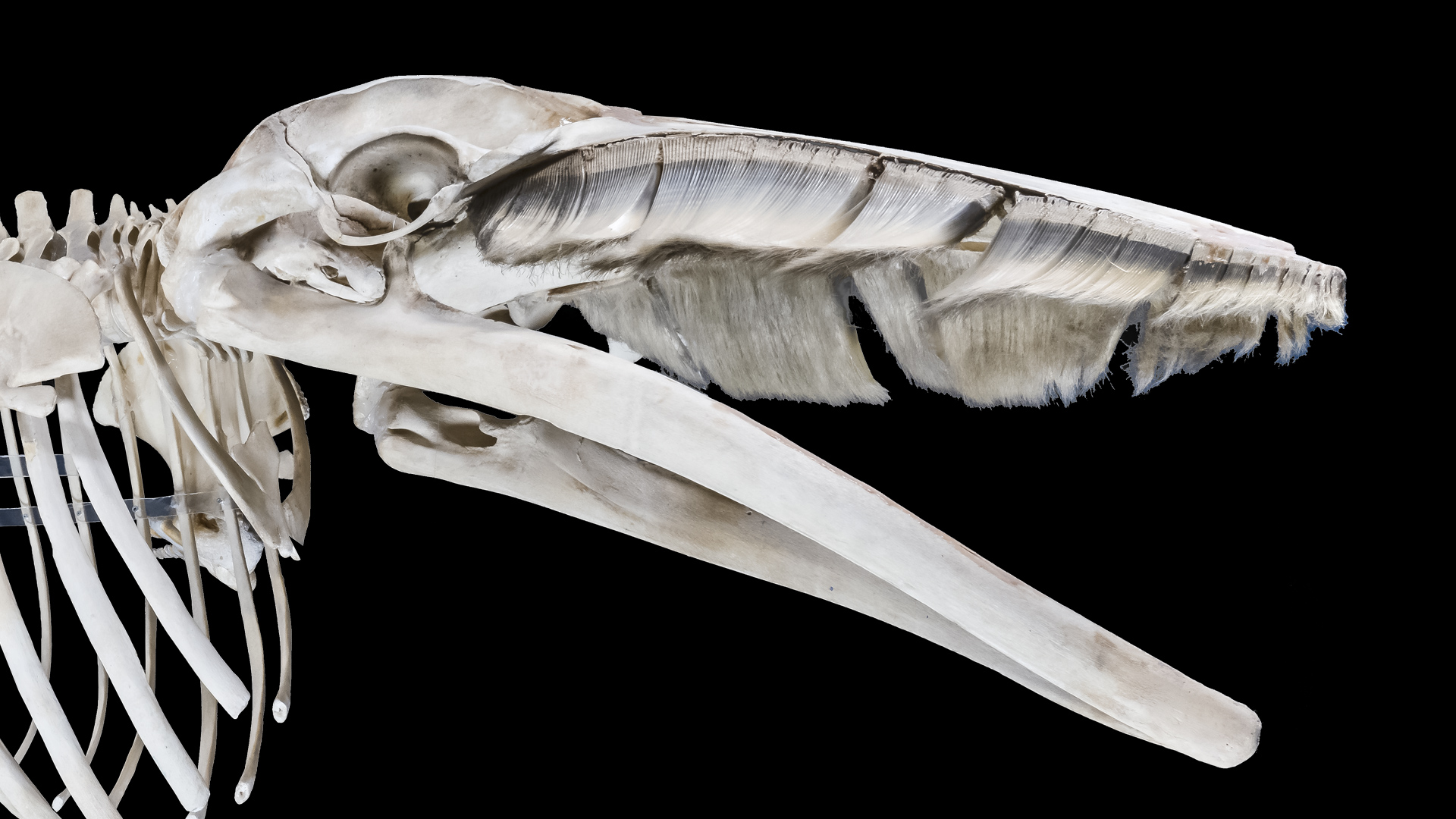
Credits: GREMM
The minke whale has short, white baleen.
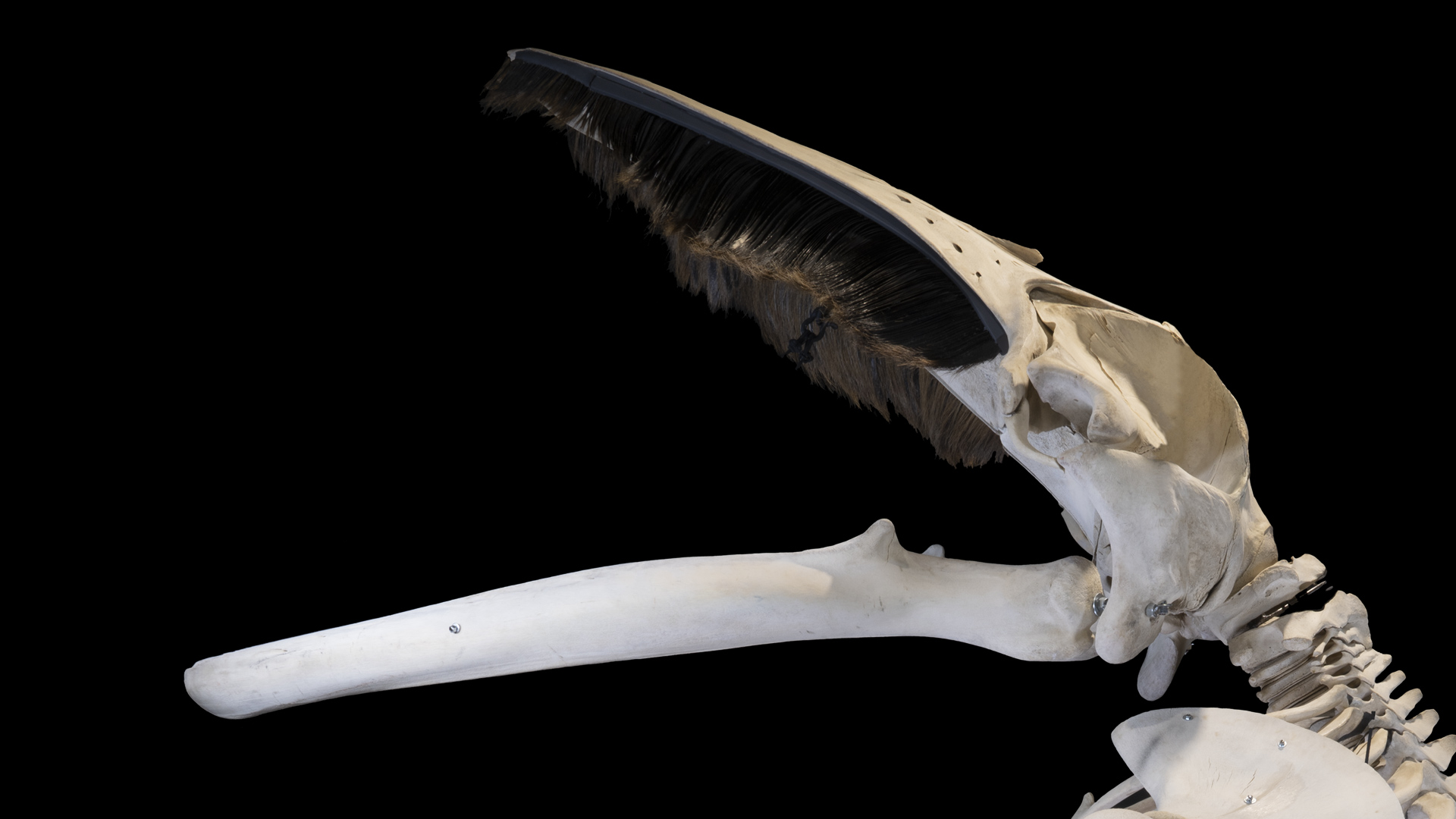
Credits: GREMM
The humpback whale has short, black baleen.

How does a whale use its baleen?
Whales like B285 and other rorquals use an engulfing technique when they feed. When they open their mouths, the skin under their chin expands like an accordion to let in thousands of litres of water that contains their food (fish or krill).
With each bite, the throat doubles in size. But the whale cannot fill its belly with salt water. This is where baleen come in handy! After each bite, the whale closes its mouth, leaving a small space between its lips; the water is then spewed out through the baleen while the food stays behind, like pasta in a colander!
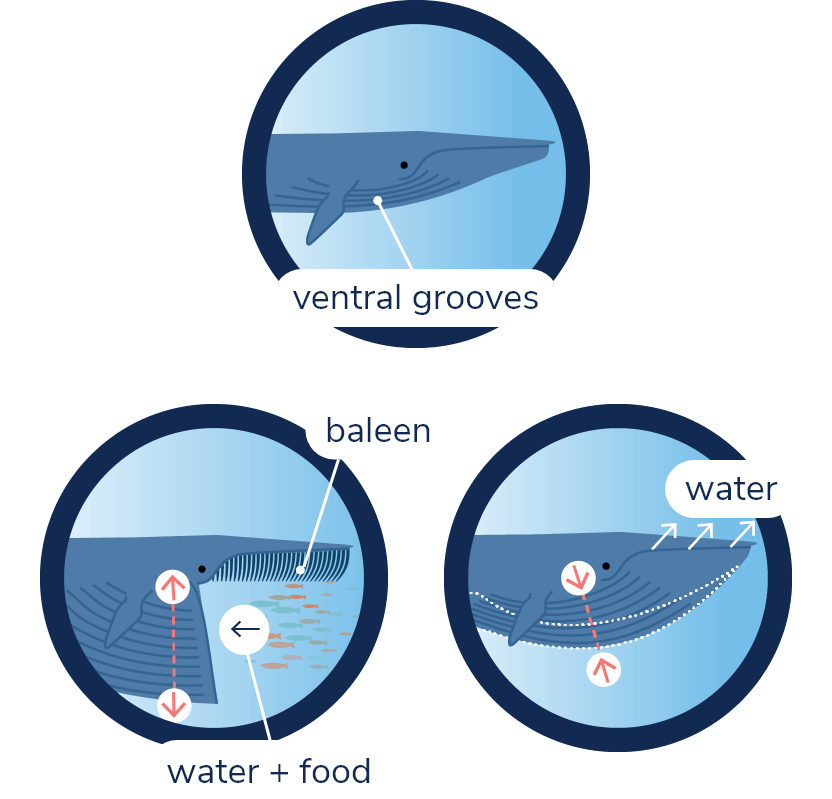

How does a whale use its baleen?
Another foraging technique is skimming. With its mouth half open, the whale slowly swims along so that prey-laden water floods its cavernous mouth.
“Gulpers” like the North Atlantic right whale and other species of right whales have a row of very long baleen on either side of the mouth, with a large gap in the middle. This is where food and water gush in. When they close their mouths to swallow their bite, water is forced out through their baleen, leaving the trapped food behind. Unlike rorquals, they have no ventral grooves.
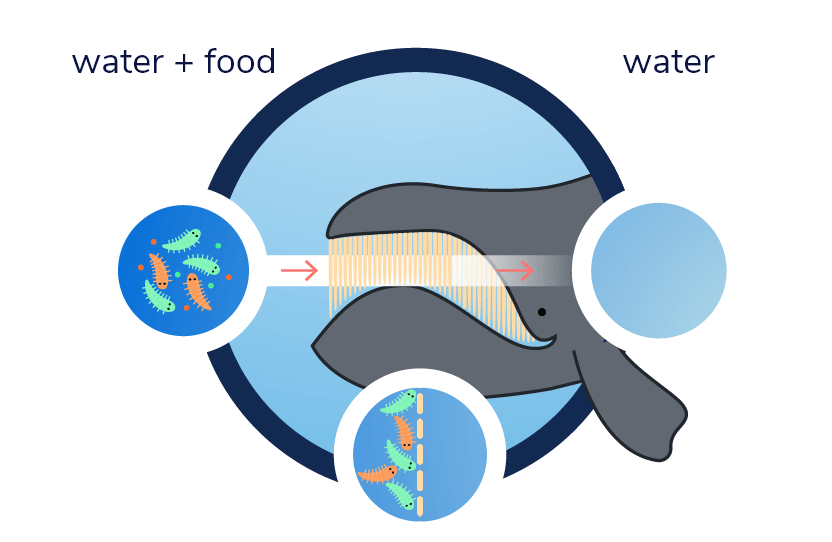

Could a whale ever swallow one of us?
Even with a mouth the size of a swimming pool, a blue whale would not be able to swallow a human! Why not? A blue whale’s esophagus is adapted to the size of its prey, with an opening about the size of a melon (15 to 25 cm).
A diver was once caught in the mouth of a whale while swimming amongst a school of fish... and was lucky enough to escape unscathed! Not because the whale could have swallowed him, but because its powerful jaw could have broken his bones or drowned him had he not gotten out in time.
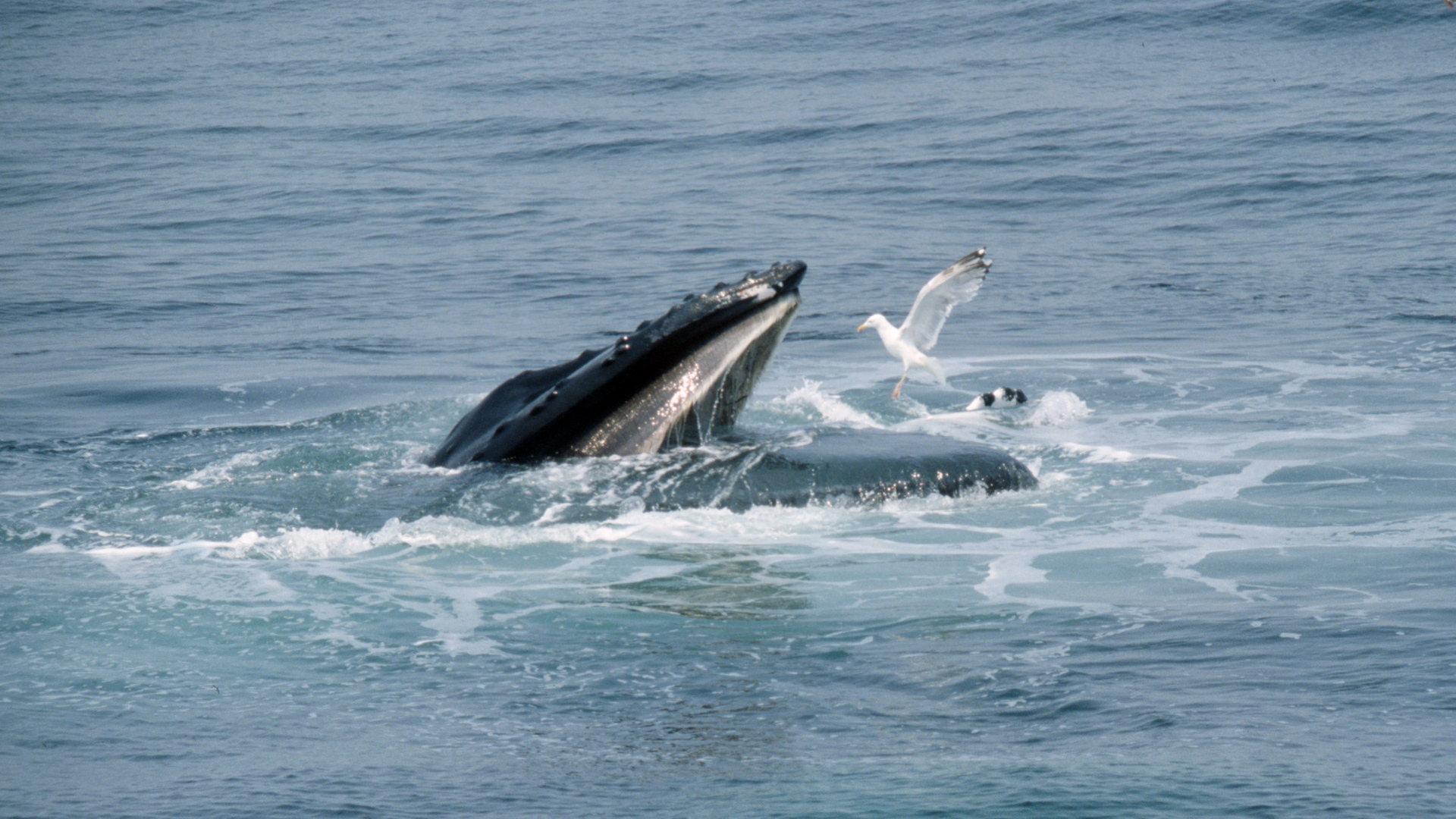
Credits: GREMM
Even a gull would be too big to be swallowed by this humpback!

How do whales digest the shells of crustaceans?
Whales don’t have hands to shell krill the way a human might peel shrimp, but this is not a problem since they are able to digest these shells. How so? Thanks to their intestinal flora.
The bacteria present in the digestive systems of baleen whales are a hybrid between those of ruminants like cows and those of carnivores like wolves. These whales are therefore capable of digesting not only the flesh of the small crustaceans they consume, but also their shells!
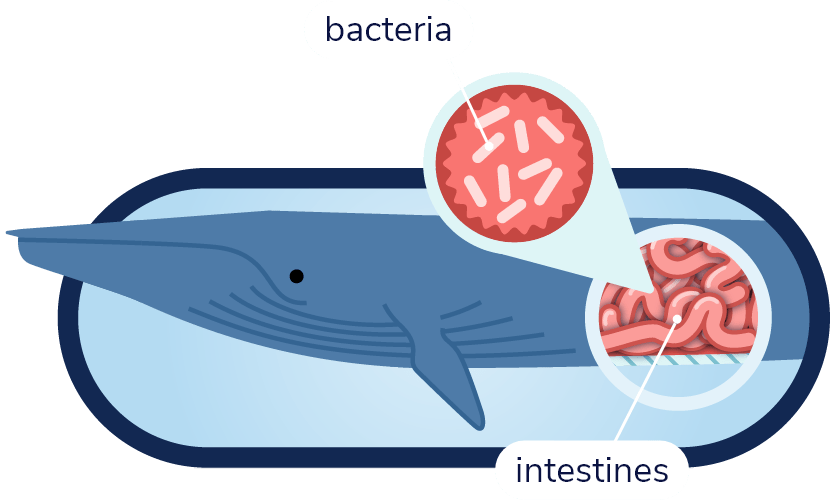

Watching whales in their natural environment is a popular activity. Some people like to observe them from as close as possible. However, if we get too close, we also risk disturbing them.
And the longer we spend in an area with heavy boat traffic, the greater the potential for disturbance. One might think that if a whale is disturbed, it will just swim away... but it might not be that simple.
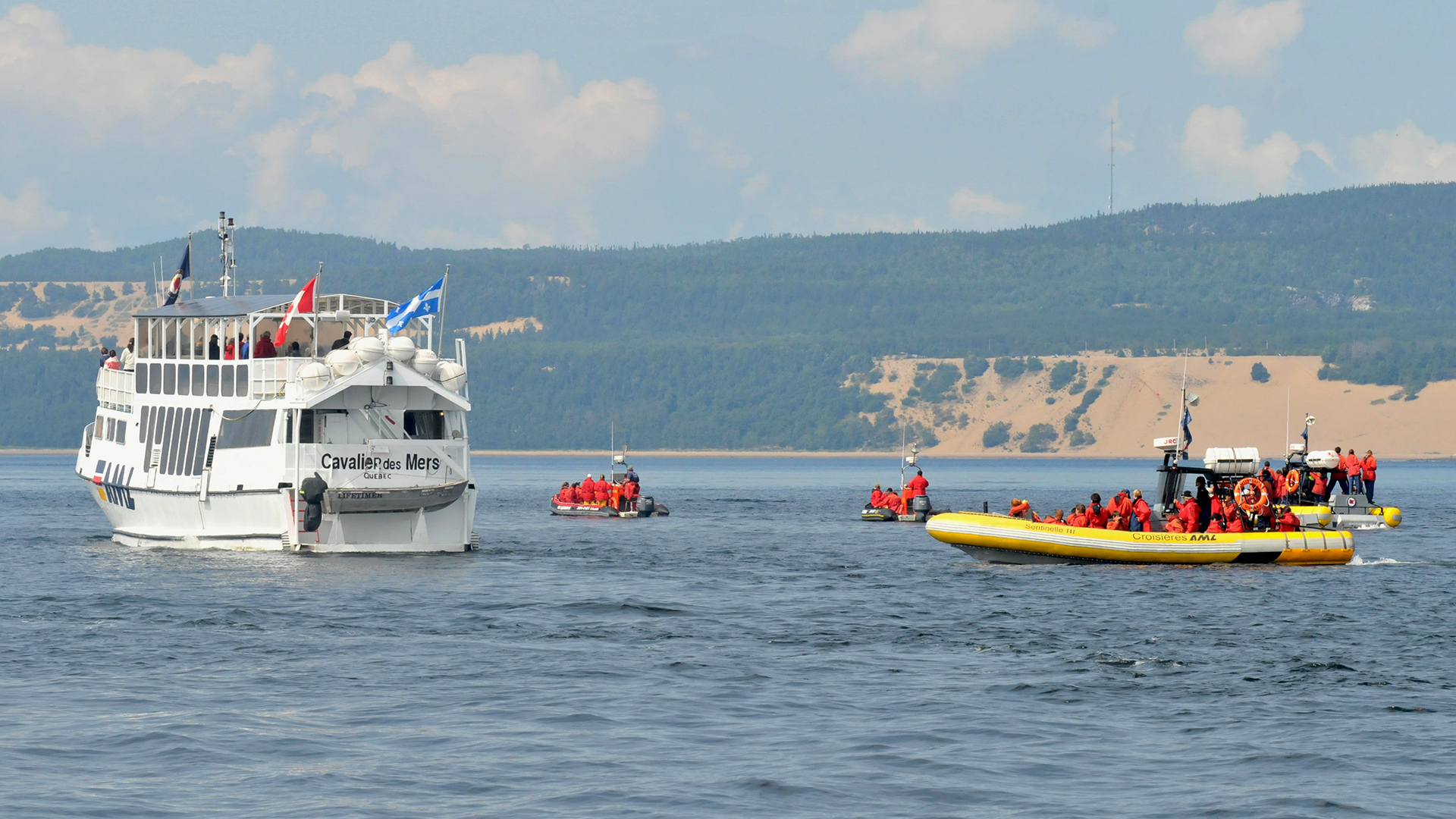
Credits: GREMM
Cruise ships wait for a whale to surface, but they must be careful to keep their distance and not to encircle it.

How do we know whether or not we’re disturbing a whale? We must be able to observe whether the animal alters its behaviour in our presence.
A study carried out in the St. Lawrence by GREMM and Parks Canada found that when whales are approached too close or by too many boats at the same time, they curtail their foraging activities.
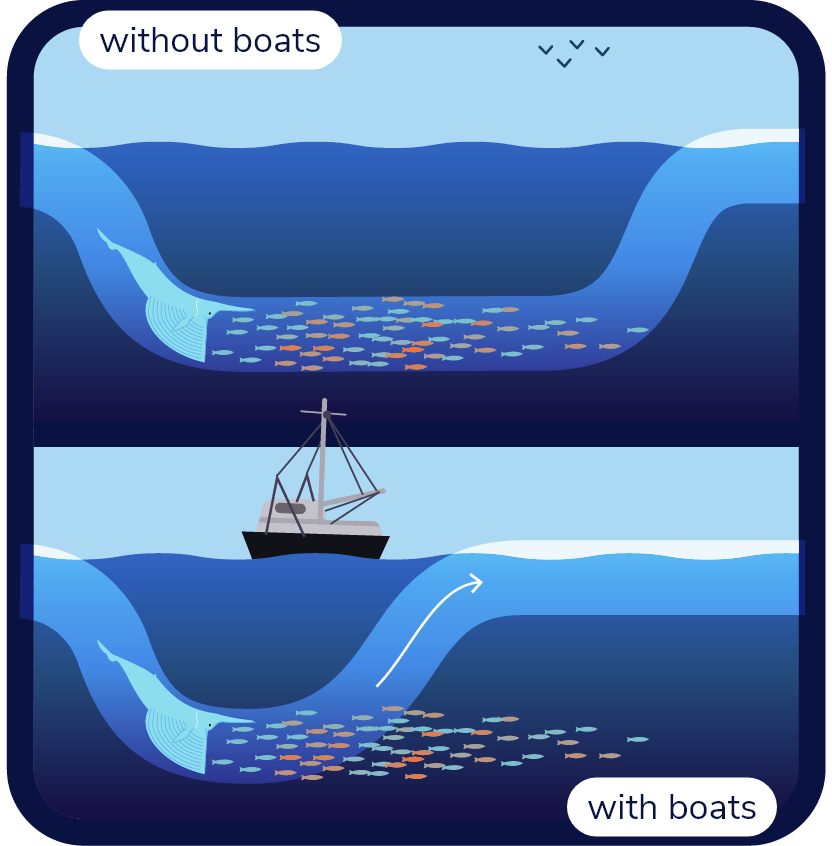
Transmitters were placed by GREMM on the backs of several whales to record their dive data; meanwhile, Parks Canada deployed its echo sounder to confirm the presence of underwater prey. By comparing situations with boats to situations without, it was found that when there were too many watercraft or when the latter were too close, the whales would take fewer bites and return to the surface more quickly.

How we approach whales influences their behaviour. In the St. Lawrence, a whale that is disturbed runs the risk of eating less...
Had B285 ever been disturbed during her mealtimes? How many times can this happen before the whale feels the effects on its health? Hard to say exactly, but we do know that a female that does not have sufficient food reserves will be unable to reproduce...
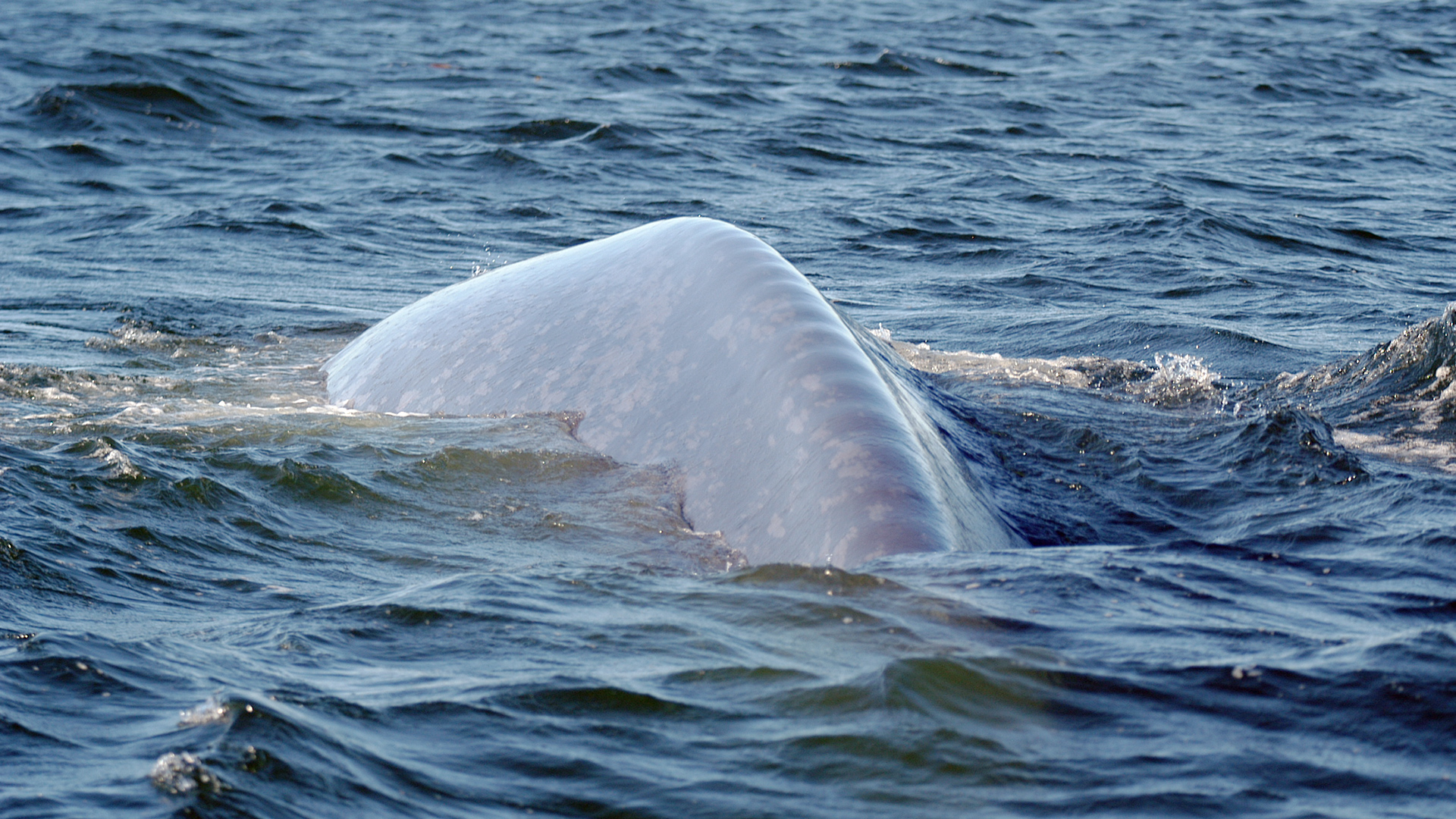
Credits: GREMM
This blue whale appears slightly emaciated. A number of factors might be to blame, but the animal’s food intake is not enough to compensate for its energy expenditure and as a result, it must draw from its reserves.

What can be done to minimize disturbance to whales?
Keep our distance from these animals.
Throughout Canadian waters, a mandatory distance of at least 100 m must be maintained from any marine mammal. In the St. Lawrence, this distance increases to 200 m, or even 400 m for threatened or endangered species such as belugas and blue whales like B285.
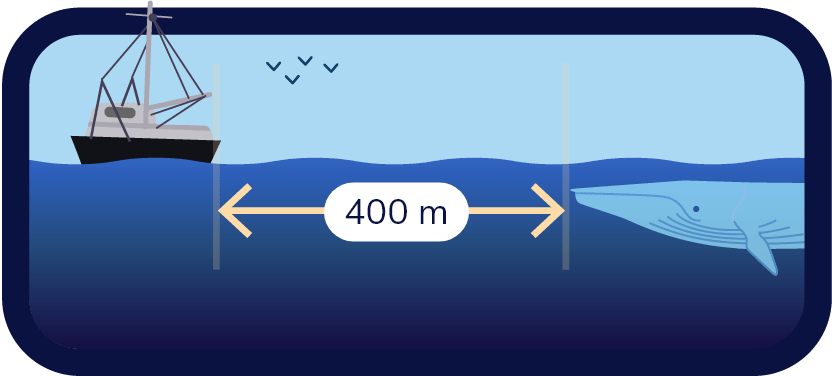

What can be done to minimize disturbance to whales?
Adopt good boating practices.
Avoid crossing a whale’s pathway as well as making rapid accelerations or sudden changes of direction. It is also important to refrain from surrounding a whale with too many boats.
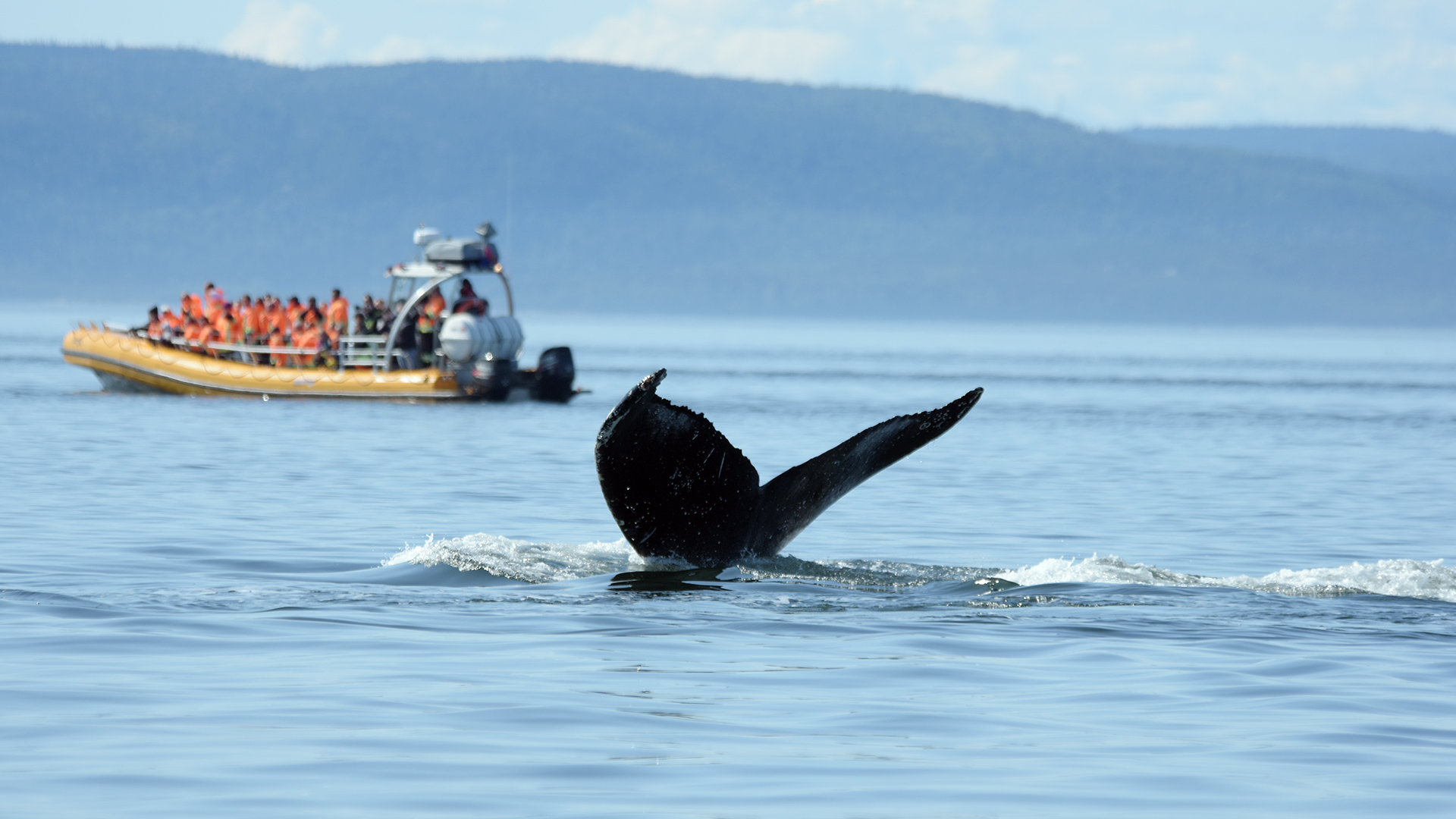
Credits: GREMM
A whale-watching boat observing a humpback slowly moves away to keep its distance and avoid getting in the whale’s pathway.

How do whales digest the shells of crustaceans?
Whales don’t have hands to shell krill the way a human might peel shrimp, but this is not a problem since they are able to digest these shells. How so? Thanks to their intestinal flora.
If you go on a whale-watching cruise, take the time to make sure that the company subscribes to a “whales-come-first” approach and, above all, do not encourage the captain to try to get a closer look!
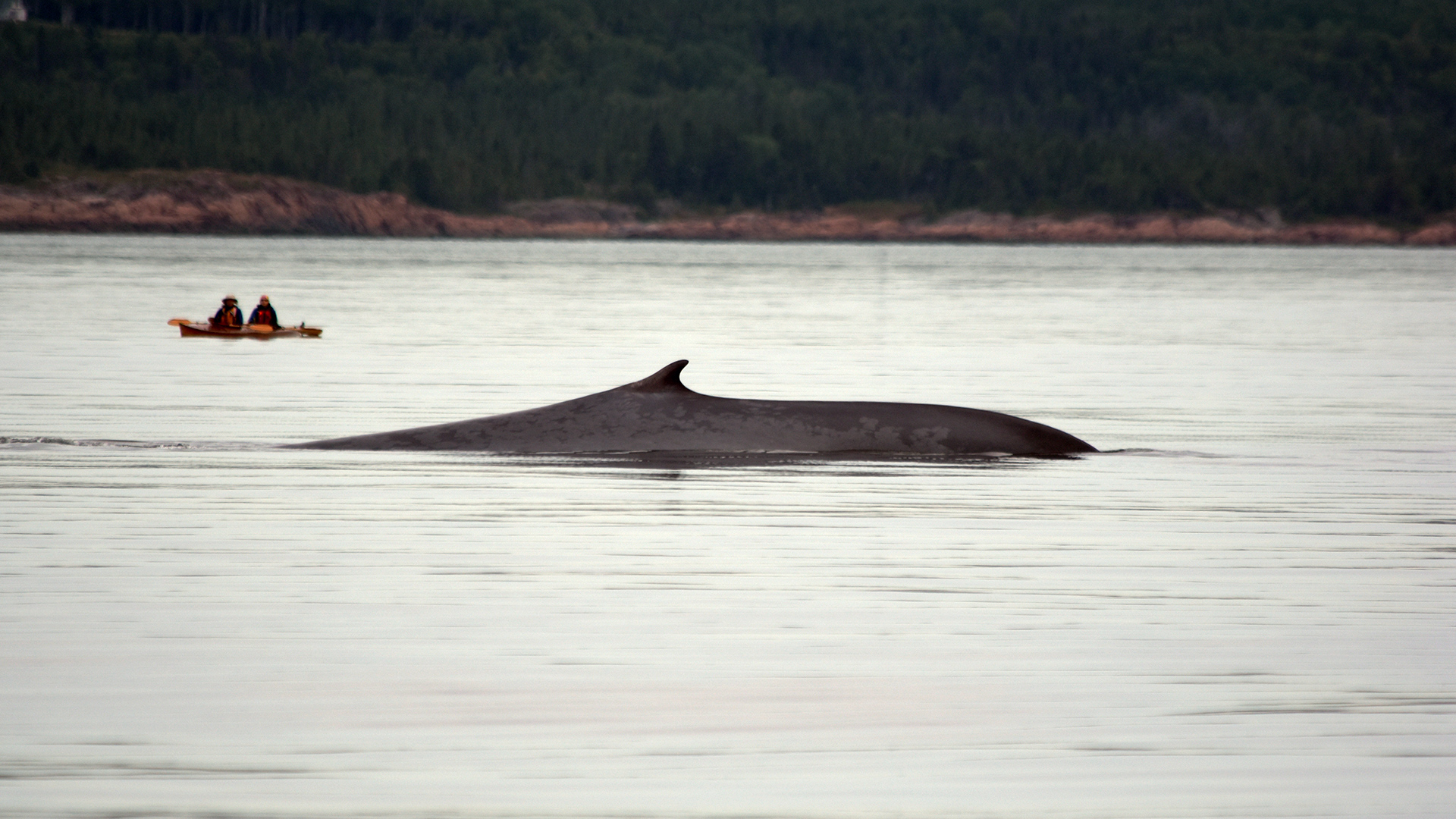
A surfacing blue whale surprises two nearby onlookers. Following this unexpected sighting, these lucky observers will have to continue on their way in order to maintain a good distance from the whale.



Now that you’ve heard B285’s story, let’s go meet the other whales!
Blue Whale
Balaenoptera musculus
Characteristics
Northwest Atlantic blue whales

Weight
50 to 110 tons, up to 135 tons

Length
21 to 28 m

Lifespan
80 years

Population
600 to 1500 individals

Status
Endangered
B285

Weight
unknown

Length
22 m

Birth - Death
Before 1989 - November 2004

ID number
B285

Sex
Female
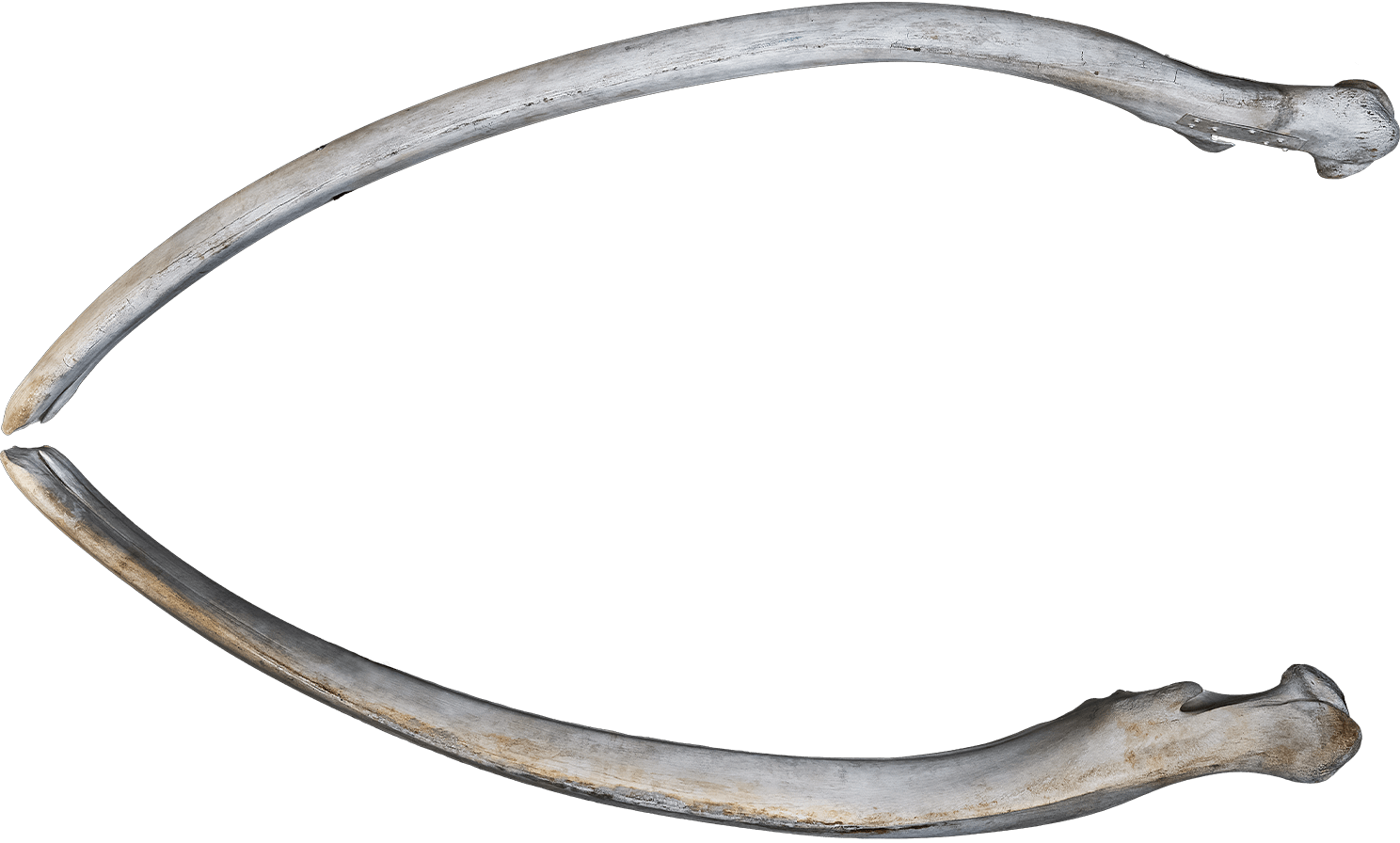
These are B285’s jawbones. These are the only bones that were recovered for display given that the rest of the skeleton was too big to fit into the exhibition room of Tadoussac’s Marine Mammal Interpretation Centre.

Blue Whale
Balaenoptera musculus
Characteristics
Northwest Atlantic blue whales

Weight
50 to 110 tons, up to 135 tons

Length
21 to 28 m

Lifespan
80 years

Population
600 to 1500 individals

Status
Endangered
B285

Weight
unknown

Length
22 m

Birth - Death
Before 1989 - November 2004

ID number
B285

Sex
Female

These are B285’s jawbones. These are the only bones that were recovered for display given that the rest of the skeleton was too big to fit into the exhibition room of Tadoussac’s Marine Mammal Interpretation Centre.

